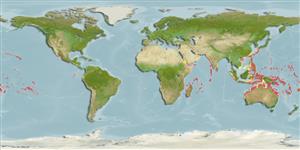Classification / Names
Common names from other countries
Main reference
Size / Weight / Age
Max length : 38.0 cm TL male/unsexed; (Ref. 1602)
Environment
Marine; reef-associated; depth range ? - 30 m (Ref. 86942)
Climate / Range
Tropical, preferred ?; 32°N - 28°S
Distribution
Indo-Pacific: widespread, from East Africa to Samoa, north to Okinawa-jima Island, Japan, excluding the Red Sea and the coast of Australia.
Countries | FAO areas | Ecosystems | Occurrences | Introductions
Short description
Vertebrae: 118 - 135. This species is distinguished by the following set of characters: 2 infraorbital pores found at the postorbital area; median ventral groove on the snout absent; acute snout; rictus of mouth slightly posterior to a vertical line through the posterior margin of the eye; pointed conical teeth on upper jaw and vomer, arranged biserially on upper jaw, uniserially on vomer; dorsal-fin origin posterior to a vertical line through the anus, horizontal distance between the origin and the vertical line 13-55% HL; tail 54-58% TL; total vertebrae 118-135, predorsal 51-57 and preanal 47-52; mean vertebral formula (MVF) 53.9-50.0-128.6 (Ref. 92899).
IUCN Red List Status (Ref. 115185)
Threat to humans
Harmless
Human uses
More information
Common namesSynonymsMetabolismPredatorsEcotoxicologyReproductionMaturitySpawningFecundityEggsEgg development
ReferencesAquacultureAquaculture profileStrainsGeneticsAllele frequenciesHeritabilityDiseasesProcessingMass conversion
Tools
Special reports
Download XML
Internet sources
Estimates of some properties based on models
Phylogenetic diversity index
PD50 = 0.5000 many relatives (e.g. carps) 0.5 - 2.0 few relatives (e.g. lungfishes)
Trophic Level
4.1 ±0.7 se; Based on size and trophs of closest relatives
Resilience
High, minimum population doubling time less than 15 months (Preliminary K or Fecundity.)
Vulnerability
Low to moderate vulnerability (25 of 100)
Price category
